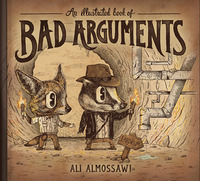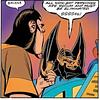Take a photo of a barcode or cover
A very short primer on informal fallacies with creepily anthropoid illustrations inspired, I guess, by Alice in Wonderland. It's not bad as a basic introduction to non-deductive flaws in argumentation, but it's very slight and hardly worth committing to paper stock. (Unless you're a fan of the illustrations. I am not.) I notice there is an amusingly negative GR review which is almost as long as the book. But apparently the book is available online for free, a noble gesture for which I award it a merit increase of one star.
The drawings in the book are amusing. The information in it is accessible to those who may have difficulty with identifying logical fallacies. Is it worth 15$? No, no it is not. Is it worth the 1$ during a sale? Perhaps. The information is widely accessible elsewhere and not presented in much length, depth, or unique fashion. It is a good start for something potentially useful and much more amusing but isn't quite there yet.
informative
inspiring
reflective
fast-paced
informative
reflective
relaxing
fast-paced
I'm going to buy this book for my grandchildren if I have any.
Had a friend recommend this so I read it on line and am happy to have done so. Clear, concise and funny.
This short little book is a good look at some of the most common fallacies. It has good use of illustrations and does a very good job conveying the information.
The explanations were good, but I was a little disappointed in the illustrations. Sometimes they were just confusing.
Probably more like 2.5.
Logical fallacies can be difficult to define and explain in laymen's terms. In my experience in various composition classes, it's not until we get to the examples of the fallacies that it finally clicks. I was hoping that, since this was a short book, it would word things in a way that were less technical and easier to understand. Essentially something that dumbed things down a bit for the sake of shortness.
However, this book, sadly, is no different than many textbook chapters on the topic. The author uses lots of "jargon" that had me reading and rereading the descriptions to try and understand what was trying to be defined. It wasn't until the example(s) were given that I understood "OH, you mean this kind of argument/statement!" Although they were short definitions, I had to read everything slowly, out loud, to really focus on the definitions. I understand that, while many fallacies may be easy to recognize or understand, they can be difficult to put into words. But that doesn't mean that the only way to describe and define them is with the technical terms--it may be proper, but it's not the only way. It seems as if the book itself is a bit of a fallacy!
That all being said, this was an enjoyable refresher on fallacies, and it gave some great examples. While I certainly wouldn't say that this should be required reading for every English class, it would be fun to see it used in some instances. Fallacies always seem to me a bit of a paradox--like, arguing something is a fallacy by using a fallacy--and I do enjoy learning about them, despite the sometimes confusing definitions.
The illustrations were fun, but it was their captions--not the actual pictures themselves--that gave another example of the fallacy. And despite the inclusion of pictures, this definitely isn't written as a kids book. Which is unfortunate, because politicians could definitely use something like this. They helped bump the rating up a half star.
I read this online: https://bookofbadarguments.com/#
Logical fallacies can be difficult to define and explain in laymen's terms. In my experience in various composition classes, it's not until we get to the examples of the fallacies that it finally clicks. I was hoping that, since this was a short book, it would word things in a way that were less technical and easier to understand. Essentially something that dumbed things down a bit for the sake of shortness.
However, this book, sadly, is no different than many textbook chapters on the topic. The author uses lots of "jargon" that had me reading and rereading the descriptions to try and understand what was trying to be defined. It wasn't until the example(s) were given that I understood "OH, you mean this kind of argument/statement!" Although they were short definitions, I had to read everything slowly, out loud, to really focus on the definitions. I understand that, while many fallacies may be easy to recognize or understand, they can be difficult to put into words. But that doesn't mean that the only way to describe and define them is with the technical terms--it may be proper, but it's not the only way. It seems as if the book itself is a bit of a fallacy!
That all being said, this was an enjoyable refresher on fallacies, and it gave some great examples. While I certainly wouldn't say that this should be required reading for every English class, it would be fun to see it used in some instances. Fallacies always seem to me a bit of a paradox--like, arguing something is a fallacy by using a fallacy--and I do enjoy learning about them, despite the sometimes confusing definitions.
The illustrations were fun, but it was their captions--not the actual pictures themselves--that gave another example of the fallacy. And despite the inclusion of pictures, this definitely isn't written as a kids book. Which is unfortunate, because politicians could definitely use something like this. They helped bump the rating up a half star.
I read this online: https://bookofbadarguments.com/#





